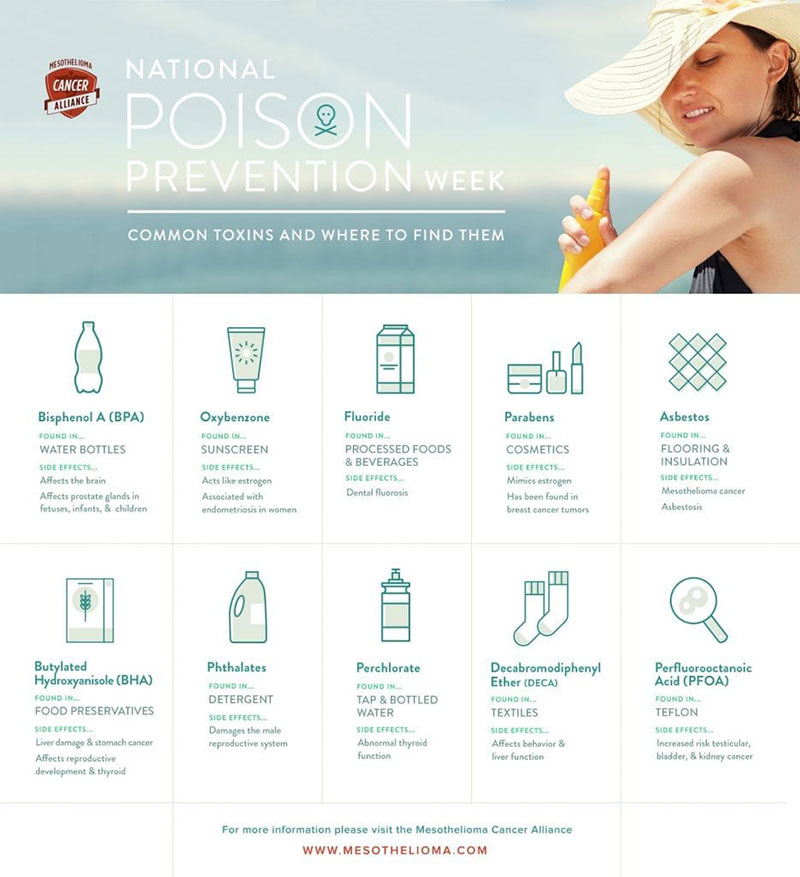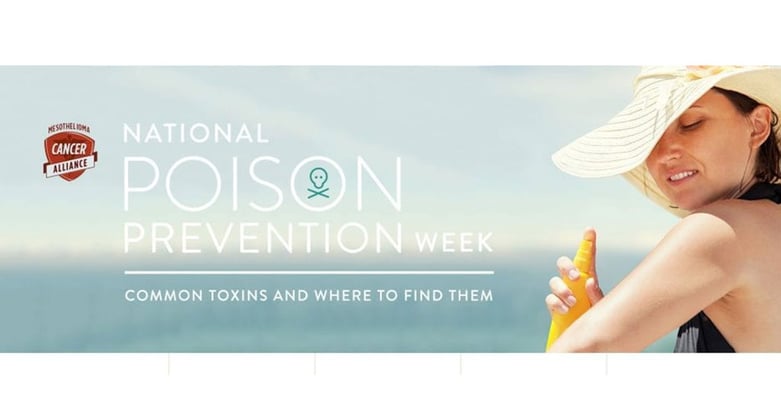Editor's Note: Not all the "toxins" listed in the infographic above have been scientifically proven to be dangerous. We are publishing it to make consumers aware that some feel these items might be harmful.
Each year the third week of March, the American Association of Poison Control Centers (AAPCC) works with 55 U.S poison centers to highlight awareness about poisoning in the USA and ways to prevent it. This marks the 55th Annual National Poison Prevention Week from March 19 to 25, 2017, according to the AAPCC.
The UMHS Endeavour includes a post each year to help raise awareness of poisons in the home. This year, we interviewed Charles MacGregor of the Mesothelioma Cancer Alliance about not only removing common household poisons from the home, but things that could put you at risk for mesothelioma, a type of cancer caused by exposure to asbestos.

Image: Courtesy of Mesothelioma Cancer Alliance
We have all seen ads on TV for law firms that represent workers who develop mesothelioma after years of exposure in certain vocations, but the risk of mesothelioma isn’t always limited to occupational asbestos exposure. Older homes could have asbestos in everything from insulation to flooring, shingles, and more. Asbestos was also used in hair dryers, baby powder (prior to the early 1980s) and automotive parts in the past.
The UMHS Endeavour spoke to Mr. MacGregor about what people should know about poisons in the home in general and more.
UMHS Endeavour: Why did the Mesothelioma Cancer Alliance get involved in Poison Prevention Week?
Charles MacGregor: Our organization spends a majority of the time working to raise awareness for mesothelioma, an incredibly rare and aggressive cancer caused by exposure to asbestos. Many people understand the dangers of breathing in asbestos particles, but the material is still not banned in the United States.
We’ve decided to get involved in Poison Prevention Week because toxins come in all shapes and sizes, and in some cases you may not even know they’re there. It’s important to know what common toxins are inside your home, whether it’s a few poorly marked bottles of cleaners and bleach, or asbestos pipe insulation and radon in your basement. We wanted to help do our part to make sure everyone is able to live happy and healthy lives.
What tips do you have for helping Americans rid their homes of poisons and toxic materials?
For the most part, simply being aware of what products contain asbestos and where they are in your home goes a long way toward staying safe. There are a lot of people who love older homes because it gives them a chance to take on some of the handyman projects they can feel good about once they’re done. The trouble is that many older homes may still have asbestos insulation, flooring, shingles, and plenty of other items and applications where the substance could have been used.
If you’re doing a DIY project, make sure to NEVER try to move or remove products containing asbestos by yourself. You could expose yourself, or others, to inhalation. If you’re working in an area known to contain asbestos, call a licensed professional who can either encapsulate the asbestos products or properly remove them from your home.
As for other poisons and toxins, it is important to remember that “an ounce of prevention is worth a pound of cure.” In the case of common household cleaners and other products, make sure they’re not in an easily accessible spot children can reach. If you’re dealing with other poisons like radon and lead, it’s best to leave their removal and mitigation to the professionals.
What household products or items may contain asbestos and should be thrown out? Should any precautions be made when disposing of these items?
Years ago, asbestos was heralded for its heat resistance and strength. As a result, the material found its way into everything from ceiling tiles and adhesives to attic insulation and even baby powder. Asbestos was also found in many automotive brake applications and clutch parts. Today, there is a federal law in place mandating that all newly manufactured products contain less than one percent asbestos, and there are plenty of safe alternatives available on the market.
The main problem with trying to remove asbestos comes when the products are disturbed or broken, creating a dust containing friable fibers (loose fibers in the air). When you breathe that dust in, it settles in your lungs and can remain latent for decades, eventually resulting in diseases like mesothelioma, asbestosis [a non-cancerous lung ailment] and lung cancer. If you have household items that you know contain asbestos, NEVER try to get rid of them or throw them out on your own. A professional is adequately trained to not only remove asbestos, but can also properly dispose of it.
For more information on products that may contain asbestos read here.
Do you think asbestos can be completely banned in the USA?
Oddly enough, the EPA did have a rule in place in 1989 effectively banning asbestos under the Toxic Substances Control Act, but was vacated two years later. Since then, numerous groups have worked hard to see asbestos be banned in the U.S., joining about 60 other countries that have already done it.
Late last year, the EPA announced the first ten chemicals it would review under new TSCA legislation, amended by the Frank R. Lautenberg Chemical Safety for the 21st Century Act, and asbestos was on the list. The Lautenberg Act beefed up the EPA’s health protections, but also holds the agency accountable for what chemicals are safe enough for the market.
It is our mission to fight to have asbestos banned in the U.S., and seeing asbestos on the EPA’s short list of chemicals reviewed first is pretty heartening. Time will tell what happens, but we’ve got our fingers crossed that asbestos will soon become a thing of the past.
For more detailed information on mesothelioma, please visit https://www.mesothelioma.com/mesothelioma/
Note: The website above is sponsored by a law firm specializing in asbestos injury litigation. The UMHS Endeavour is providing the link for informational purposes only and is not responsible for its content.
This year, the following daily themes are being promoted by the National Poison Prevention Council:
The following daily themes will be promoted in 2017:
- Monday, March 20 – Children Act Fast … So Do Poisons
- Tuesday, March 21 – Poison Centers: Saving You Time and Money
- Wednesday, March 22 – Poisonings Span a Lifetime
- Thursday, March 23 – Home Safe Home
- Friday, March 24 – Medicine Safety
For more information on National Poison Prevention Week, visit http://www.aapcc.org/prevention/nppw/
About UMHS:
Built in the tradition of the best US universities, the University of Medicine and Health Sciencesfocuses on individual student attention, maintaining small class sizes and recruiting high-quality faculty. We call this unique approach, “personalized medical education,” and it’s what has led to our unprecedented 96% student retention rate, and outstanding residency placements across the US and Canada. UMHS is challenging everything you thought you knew about Caribbean medical schools.

Scott is Director of Digital Content & Alumni Communications Liaison at UMHS and editor of the UMHS Endeavour blog. When he's not writing about UMHS students, faculty, events, public health, alumni and UMHS research, he writes and edits Broadway theater reviews for a website he publishes in New York City, StageZine.com.















